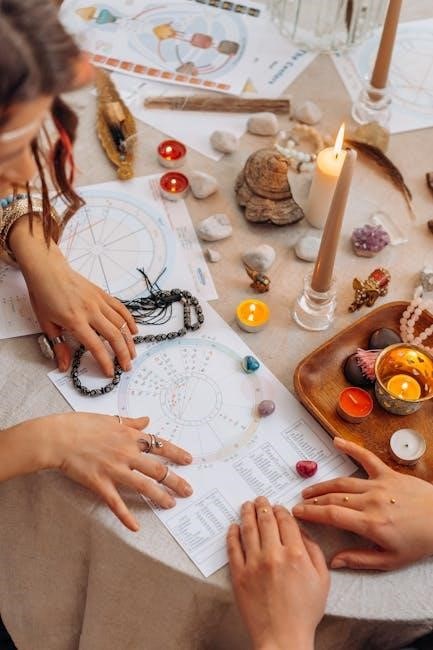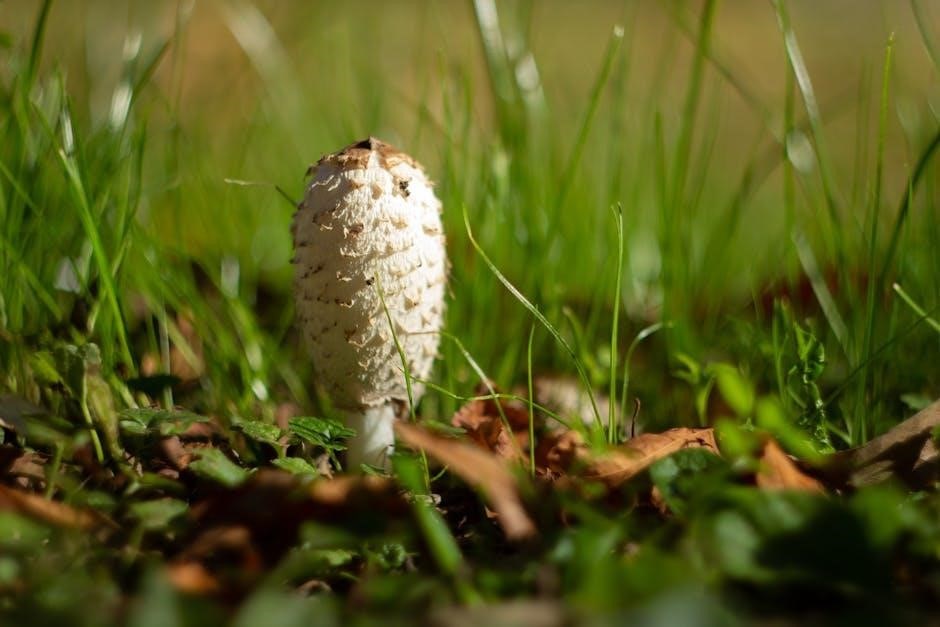Crystal Growing Kit Instructions PDF: A Comprehensive Guide
Embark on a crystalline adventure! This comprehensive guide dives into crystal growing kits, offering downloadable PDF instructions from manufacturers, retailers, and educational resources. Discover the secrets to transforming simple solutions into dazzling masterpieces.
Crystal growing kits offer a fascinating window into the world of chemistry and geology, suitable for hobbyists and educational purposes alike. These kits typically contain all necessary materials to cultivate your own crystals at home, providing a hands-on learning experience. From simple single crystals to complex formations, these kits inspire scientific curiosity and provide a rewarding sense of accomplishment.
Understanding the Components of a Crystal Growing Kit
Crystal growing kits come with various components, including crystal-growing compounds, containers, and seed crystals. Knowing each component’s purpose is key to successfully creating beautiful and unique crystals. This section will break down each element.
Basic Kit Contents
Typically, a basic crystal growing kit contains a crystal-growing chemical compound such as potassium alum or monoammonium phosphate, a container or growing dish, a seed crystal or starter rock, stirring tools, and detailed instructions. Some kits include safety equipment, chemicals, dye, stones, and a magnifying glass, and growing papers, ensuring a safe and successful crystal-growing experience for beginners.
Additional Items That May Be Included
Beyond the essentials, some crystal growing kits enhance the experience with extras like coloring dyes to create vibrant crystals, display stands to showcase your creations, and magnifying glasses for closer observation. Safety goggles and gloves might be included for safe handling, while educational booklets or experiment guides offer deeper insights into crystal formation and scientific principles.
Safety Precautions When Using Crystal Growing Kits
Prioritize safety! Crystal growing kits often contain chemicals. Adult supervision is crucial, especially for young children. Always follow instructions carefully, wear appropriate protection, and know basic first aid procedures in case of accidents.
Adult Supervision Requirements
Due to the presence of chemicals and the need for precise measurements, adult supervision is essential when children use crystal growing kits. Adults should carefully read all instructions, ensure a safe experimental environment, and guide children through each step of the crystal-growing process. This helps prevent accidents, ensures proper handling of materials, and enhances the learning experience. Keep children under 8 away from experiments.
Handling Chemicals Safely
When working with crystal growing kits, always handle chemicals with care. Avoid contact with skin, eyes, and clothing. Use the provided safety equipment, such as gloves and goggles. Never ingest any chemicals. In case of spills, rinse the affected area with plenty of water. Ensure proper ventilation during experiments. Store chemicals in a secure location, out of reach of children and animals. Read all safety information.
First Aid Information
In case of chemical contact, immediately rinse the affected area with plenty of water. For eye contact, flush with water for at least 15 minutes and seek medical attention. If a chemical is ingested, contact a poison control center or medical professional immediately. Do not induce vomiting unless directed by medical personnel. Always refer to the kit’s manual for specific first aid instructions and seek prompt medical advice.

Step-by-Step Instructions for Crystal Growth
Unlocking crystal formation requires precise execution. Follow these steps: solution preparation, creating the ideal environment, and careful observation. Achieve crystalline perfection using the kit’s instructions and a bit of patience.
Preparing the Crystal Growing Solution
The foundation of crystal growth lies in the solution. Typically, this involves dissolving crystal-forming chemicals in boiling water. Ensure accurate measurements, often around 200ml of water, for optimal saturation. Stir continuously until the solution becomes clear and no undissolved particles remain. This carefully prepared solution sets the stage for successful crystal development.
Setting Up the Growing Environment
Creating a stable environment is vital for crystal formation. Select a location with a consistent temperature, away from direct sunlight and vibrations. Place the crystal growing container on a level surface, ensuring it remains undisturbed. A controlled environment minimizes external factors, allowing crystals to grow steadily and develop their characteristic shapes without disruption.
Monitoring Crystal Formation
Observe the crystal growth daily, noting any changes in size, shape, or clarity. Use a magnifying glass for detailed inspection. Resist the urge to disturb the crystals. Be patient; crystal formation takes time. Record observations to track progress and understand the impact of different factors. Proper monitoring helps identify potential issues early on.
Troubleshooting Common Problems
Experiencing issues with your crystal growth? This section addresses common problems like lack of crystal formation, small or poorly formed crystals, and cloudy solutions. We provide solutions to help you achieve optimal results.
No Crystal Growth
If you’re experiencing a complete absence of crystal formation, several factors could be at play. Ensure the solution was properly prepared, using the correct water temperature (boiling is often optimal). Verify that the solution wasn’t disturbed and is placed where the temperature remains relatively constant. Impurities or incorrect saturation levels can also hinder crystal growth. Review instructions and re-attempt preparation.
Small or Poorly Formed Crystals
Disappointed with tiny or misshapen crystals? This often stems from rapid temperature changes or vibrations during the growing process. Ensure a stable environment. Insufficient solution saturation or premature termination of the growth period can also yield unsatisfactory results. Allow the crystals ample time to develop. Consider experimenting with temperature control and solution concentration for optimal results.
Cloudy Solution
A cloudy crystal-growing solution can hinder crystal formation. This cloudiness often indicates impurities or undissolved solids in the mixture. Ensure thorough mixing and use distilled water. Sometimes, the saturation point is exceeded, leading to precipitation. Gently heating the solution might help, but avoid boiling. Carefully filter the solution to remove particulate matter and promote clearer crystal growth.
Different Types of Crystals You Can Grow
Crystal growing kits offer diverse options! Explore growing single crystals for scientific elegance. Create crystal clusters for dazzling displays. Venture into geodes, mimicking nature’s hidden treasures. Each type presents unique challenges and stunning results.
Single Crystals
Growing single crystals involves patience and precision. These individual formations showcase the pure beauty of crystalline structure. Kits often provide specific chemicals and instructions tailored for single crystal growth. Maintaining a stable environment is crucial for achieving large, well-defined single crystals. Follow the kit instructions closely, paying attention to temperature control and solution concentration, to maximize your chances of success in cultivating these impressive specimens.
Crystal Clusters
Crystal clusters offer a different aesthetic, showcasing an aggregate of intergrown crystals. These formations often develop when multiple nucleation sites are present. Growing crystal clusters can be achieved by slightly modifying the conditions used for single crystals. The instructions may advise introducing seed crystals or allowing for more rapid cooling. These clusters display a more complex and textured appearance, making them visually appealing and interesting to observe under magnification.
Geodes
Geodes are fascinating formations, essentially hollow rocks lined with crystals. While recreating a natural geode perfectly with a kit is challenging, you can simulate the effect. Instructions often involve creating a shell (using plaster or a similar material) and then encouraging crystal growth within that cavity. The result is a stunning display that mimics the beauty of naturally occurring geodes, offering a glimpse into geological processes and crystal formation within a contained space.

Experimenting with Different Variables
Unleash your inner scientist! Explore the fascinating world of crystal growth by experimenting with variables. Temperature, solution concentration, and seed crystal selection all play critical roles. Fine-tune these elements to achieve unique crystal formations.
Temperature Control
Maintaining a stable temperature is crucial for optimal crystal growth. Select a location where temperatures remain relatively constant, avoiding drafts or direct sunlight. Fluctuations can disrupt crystal formation, leading to smaller or poorly formed crystals. Experiment with slightly varying temperatures to observe their effects on crystal size, shape, and clarity, keeping detailed records of your observations for future reference.
Solution Concentration
The concentration of the crystal-growing solution significantly impacts crystal formation. Carefully measure and mix the components according to the kit instructions. Experimenting with slightly higher or lower concentrations can influence crystal size and growth rate. Too dilute, and crystals may not form; too concentrated, and they may form too quickly or be of poor quality. Always document your adjustments for consistent results.
Seed Crystal Selection
The seed crystal acts as a template for further crystal growth. Selecting a high-quality seed crystal is crucial for achieving large, well-formed crystals. Choose a seed crystal that is clear, has defined edges, and is free from imperfections. You can use a small crystal from a previous experiment or a commercially available crystal. Attach it carefully to a thin line for suspension in the solution.

Storing and Displaying Your Crystals
Properly storing and displaying crystals protects them from damage and showcases their beauty. Cleaning gently, protecting from impacts, and choosing suitable display options are key. Explore various display cases and stands for your creations.
Cleaning the Crystals
Cleaning the Crystals
Once your crystals have finished growing, carefully remove them from the solution. Gently rinse them with distilled water to remove any remaining residue. Avoid using tap water, as it contains minerals that can cloud the crystal’s surface. Pat them dry with a soft, lint-free cloth, being mindful of their delicate structure, to maintain their shine.
Protection from Damage
Protection from Damage
Crystals are delicate and can be easily damaged. To protect your newly grown crystals, avoid exposing them to direct sunlight or extreme temperatures, as these can cause discoloration or cracking. Store them in a display case or a soft, padded box to shield them from dust, scratches, and accidental impacts, preserving their beauty for years to come.
Display Options
Display Options
Showcase your crystal creations with pride! Consider using clear display cases to protect them from dust and damage while allowing for optimal viewing. Lighted bases can enhance their sparkle and brilliance. Arrange them individually on shelves or group them together to create a stunning mineral collection. Get creative with backdrops and angles for visually appealing presentations.
Advanced Crystal Growing Techniques
Ready to take your crystal growing to the next level? Explore advanced techniques, such as utilizing different chemicals and methods for growing larger, more perfect crystals.
Growing Large Crystals
Growing large crystals requires patience and precision. Start with a saturated solution and maintain a stable temperature. Introduce a seed crystal and ensure minimal disturbances. Regularly check the solution’s concentration and add more crystal-growing powder if needed. Prevent dust and debris from entering the container. With consistent care, you can cultivate impressive, large crystals.
Using Different Chemicals
Experimenting with different chemicals can yield unique crystal formations. Research the safety and properties of each chemical before use. Ensure adequate ventilation and wear appropriate protective gear. Mix chemicals in proper ratios and observe the crystal growth process carefully. Note that some chemical combinations can be dangerous, so proceed with caution and consult reliable sources.

Where to Find Crystal Growing Kit Instructions PDF Downloads
Accessing crystal growing kit instructions is easy! Check manufacturer websites, online retailers like Kmart and Amazon, and educational resource pages. Many provide downloadable PDFs for safe and successful crystal creation.
Manufacturer Websites
Official manufacturer websites are a prime source for crystal growing kit instructions in PDF format. Companies like Trends UK, 4M, and Evviva Sciences often provide downloadable manuals. These PDFs ensure you have the correct guidelines for their specific kits. Check their support or product pages for easy access to these valuable resources.
Online Retailers
Major online retailers like Kmart and Amazon often host PDFs of crystal growing kit instructions. Check the product description or support sections on their websites. You might find links to download the manual directly. User reviews or Q&A sections can also provide valuable links or information about obtaining the instructions in PDF form.
Educational Resources
Educational websites and science-focused platforms provide crystal growing kit instructions in PDF format. Explore sites from science museums or educational toy companies like Evviva Sciences. Look for sections dedicated to science experiments or educational resources, where you may find downloadable guides and manuals to help you grow amazing crystals safely and effectively.
